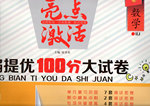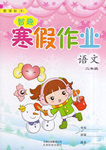题目内容
The aim isn't to persuade people to _________, but to stick to their beliefs.
- A.make up their minds
- B.put their minds
- C.change their minds
- D.turn their minds

 亮点激活精编提优100分大试卷系列答案
亮点激活精编提优100分大试卷系列答案 智趣寒假作业云南科技出版社系列答案
智趣寒假作业云南科技出版社系列答案Looking back on China's road to outer space, people can easily find it has not been very smooth.In the past years, Chinese people have made hard and determined efforts to realize the dream their ancestors had for thousands of years.
After China's first satellite into the Earth's orbit in 1970 came four flights of unmanned Shenzhou spaceflight from 1999 to 2002.The country carried out its first one-piloted spaceflight in October.2003, making China the third country in the world to have independent human spaceflight ability after the Soviet Union and the United States.Then came another breakthrough on October 12, 2005. when Shenzhou 6, China's second human spaceflight, was launched, with a crew of two astronauts.What's more, the landmark (里程碑 )spacewalk done by Zhai Zhigang, one of the three boarding Shenzhou 7, launched on Sept.25, 2008, leads the country further in its space exploration.
when Shenzhou 6, China's second human spaceflight, was launched, with a crew of two astronauts.What's more, the landmark (里程碑 )spacewalk done by Zhai Zhigang, one of the three boarding Shenzhou 7, launched on Sept.25, 2008, leads the country further in its space exploration.
Meanwhile, China's moon exploration project, started in 2004, has also been progressing satisfactorily. Fifty years after the Soviet Union launched Sputnik, the world's first man-made satellite, China's first circumlunar(绕月的 )satellite Chang’e 1 took off on Oct.24, 2007, which became the third landmark in China's space achievements after the above-mentioned manned flights.Change 1 was expected to fulfill four scientific goals, one of which was to explore mineral elements on the moon, especially those not existent on the Earth. It's said that the lunar regolith (月壤 ) is abundant in helium-3, a clean fuel that may support the Earth's energy demands for more than a century.Nearly 3 years later, Oct.1, 2010 witnessed the launching of Chang'e 2, China's 2nd unmanned lunar probe, marking another step forward in moon exploration.This time the aim is to test the key techniques of Chang'e 3 and Chang'e 4, as a preparation for a soft lunar landing in the future.
With great expectations, people all over the world are looking forward to China's greater space achievements.
【小题1】According to the text, which of the following is TRUE?
| A.China sent its first satellite into the Moon's orbit in 1970. |
| B.China is the third country in Asia to make human spaceflight. |
| C.By now, 5 astronauts have made successful spaceflight by Shenzhou spaceship. |
| D.The launching of Chang'e 1 became the third landmark in China's space achievements. |
A.landmark spacew alk alk | B.manned Shenzhou spaceflight |
| C.first circumlunar satellite | D.unmanned Shenzhou spaceflight |
| A.China's road to outer space has been very smooth for a long time |
| B.the lunar regolith is believed to be poor in a clean fuel called helium-3 |
| C.China's scientists are researching into techniques for soft lunar landing |
| D.China's lunar exploration project was started in 2004 and completed in 2007 |
| A.Ancient Chinese's Dream | B.The World's Great Expectations |
| C.China's Moon Exploration | D.China s Major Space Achievements |
| A.negative | B.positive |
| C.discouraged | D.uninterested |